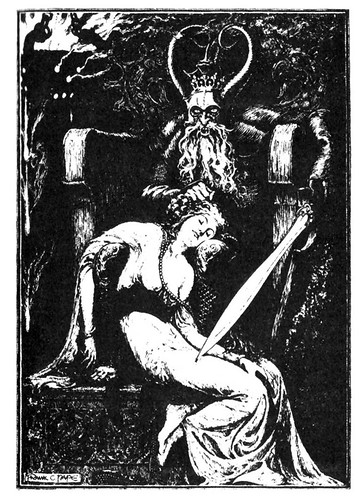By Frank C. Pape; from Jurgen by James Branch Cabell (1919).
I first found this picture more than 15 years ago in a German book, Lexikon der Symbole by Wolfgang Bauer, Irmtraud Dümotz and Sergius Golowin. It was used to illustrate (ironically, I assume) the threat of modern society against the sacrosanctity of the family...
Funny if you have read the original story, which it was used to illustrate. It is in the public domain, I believe; the entire text can be read at the University of Virginia's website dedicated to Cabell.
Showing posts with label literature. Show all posts
Showing posts with label literature. Show all posts
2009/04/03
Thragnar the Troll King and Dame Guenevere
2009/03/10
More Japanese Puppies
***
As a fan of black-and-white Japanese dogs, I was thrilled to find these images.
As a fan of black-and-white Japanese dogs, I was thrilled to find these images.

Cover of the Legend of the Eight Dog Warriors (Nansou Satomi Hakkenden), epic Japanese novel written in the period 1814-1842. (Image source)
The dog theme derives from the origin myth of the eight warriors; besieged by his enemies, warlord Satomi promises his daughter Fuse-hime in marriage to the warrior who can break the siege and bring him the head of his enemy. His faithful dog Yatsufusa obeys. In the strange marriage, Fuse-hime remains a virgin but becomes miraculously pregnant. Mortally ashamed, she kills herself, but her eight sons' (puppies?) spirits fill the jewel beads of her rosary and disappear. Eventually, the sons of Fuse-hime are born of human parents around the country, and the novel tells the story of their exploits and final reunion.
 Yatsufusa and Fuse-hime. (Source)
Yatsufusa and Fuse-hime. (Source)Edit. The dog's name, Yatsufusa (八房), means literally "eight spots". According to the novel, he was reared by a tanuki (raccoon dog, a badger-like canine with a reputation for supernatural mischief) in the village of Inugake in the Minamiboso area. Tourists can visit important locations of the novel as if it were historical fact; there is even a memorial for Yatsufusa and the tanuki (read about the Hakkenden tour in English and Japanese).
Subscribe to:
Posts (Atom)
